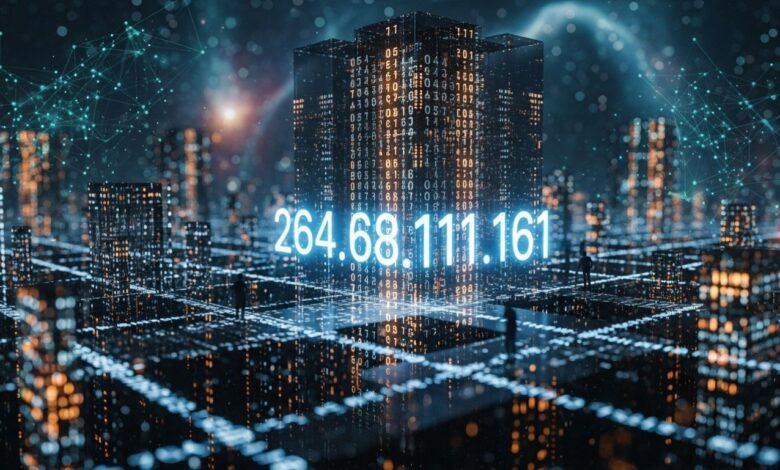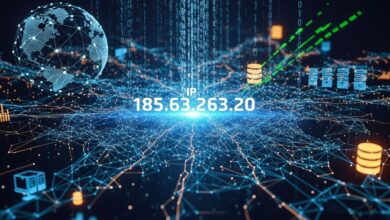264.68.111.161: The Intriguing World of IP Addresses

Welcome to the enigmatic world of IP addresses, where each number holds a unique identity in the vast digital landscape. Today, we’re diving into the specific address 264.68.111.161—a string of digits that connects devices and facilitates communication across the internet. Have you ever wondered what these numbers really mean? Or how they influence your online experience? Prepare for an enlightening journey as we unravel the mysteries surrounding IP addresses and their significance in our daily lives! Whether you are tech-savvy or just curious about how things work behind the scenes, this exploration promises to be both informative and intriguing. Let’s embark on this adventure together!
What is 264.68.111.161?
264.68.111.161 is an intriguing example of an IP address, a numerical label assigned to devices connected to a network. This specific address follows the IPv4 format, consisting of four sets of numbers ranging from 0 to 255.
Each segment represents a byte, making this structure essential for routing data across the internet. The uniqueness of every IP ensures that devices can communicate effectively without confusion.
Though it may seem arbitrary at first glance, 264.68.111.161 serves as a vital identifier in the vast web of networks and systems worldwide.
It’s crucial to remember that while IP addresses like this one are fundamental for connectivity, they can also reveal geographic information or organizational links tied to specific users or services on the internet.
The Structure of an IP Address
An IP address is like a digital fingerprint for devices connected to the internet. It consists of four sets of numbers, separated by periods. Each set can range from 0 to 255.
For instance, in the case of 264.68.111.161, each number corresponds to an octet in binary form. This structure allows computers and servers to communicate effectively.
The first part typically identifies the network itself, while the remaining segments pinpoint individual devices within that network.
This hierarchical layout enhances routing efficiency and helps manage how data packets travel across multiple networks.
Understanding this structure is essential when dealing with networking issues or configuring devices for optimal performance in both personal and business settings.
Types of IP Addresses
IP addresses come in various types, each serving a distinct purpose. The two primary categories are IPv4 and IPv6.
IPv4 is the most widely used format. It consists of four sets of numbers separated by dots, like 192.168.0.1. This version has been around since the early days of the internet but is now running out of available addresses due to its limited structure.
Enter IPv6, designed to resolve this issue with an almost infinite supply of addresses. Its complex format includes eight groups of hexadecimal digits, making it significantly more robust than its predecessor.
Additionally, IP addresses can be categorized based on their function—public or private. Public IPs connect directly to the internet while private IPs serve internal networks within homes or businesses.
There’s also the distinction between dynamic and static addresses, which affects how devices connect online and how easily they can change over time.
Public vs Private IP Addresses
Public IP addresses are like the front door to your home. They allow devices on the internet to communicate with one another. Every device connected to the web needs a public IP, ensuring it can send and receive data across networks.
On the flip side, private IP addresses serve as internal identifiers for devices within a local network. Think of them as room numbers in a large building where everyone knows their neighbors but remains shielded from external views.
The main distinction lies in accessibility. Public addresses are visible to anyone on the internet, while private ones remain hidden, providing an added layer of security. This separation is crucial for protecting sensitive information.
Organizations often utilize both types of IPs effectively. By employing public addresses for outward communication and private ones internally, they maintain functionality without sacrificing security or privacy.
How are IP Addresses Assigned?
IP addresses are assigned using a systematic approach governed by the Internet Assigned Numbers Authority (IANA). This organization oversees global IP address allocation, ensuring every device connected to the internet has a unique identifier.
When an Internet Service Provider (ISP) needs to assign IP addresses, they request blocks from IANA. The ISP then distributes these to customers and businesses. This process helps manage networks efficiently.
Dynamic Host Configuration Protocol (DHCP) is often used for assigning temporary IP addresses within local networks. This method allows devices to connect effortlessly without manual configuration.
For more permanent needs, ISPs can allocate static IP addresses. These remain consistent over time and facilitate reliable communication for servers or critical infrastructure.
This system of assignment ensures that no two devices share the same address, which is essential for seamless internet connectivity and data transmission across diverse networks.
Dynamic vs Static IP Addresses
Dynamic IP addresses are like chameleons. They change frequently, assigned by a network each time a device connects. This offers flexibility and efficient use of available addresses.
On the other hand, static IP addresses remain constant. They’re fixed to a specific device, making them ideal for services that require reliable connectivity such as web hosting or remote access.
Dynamic addressing is generally easier to manage. It reduces the burden on network administrators who need not track every changing address.
Static IPs provide stability but come with higher costs and can be less secure if not protected properly.
Both types serve distinct purposes in networking environments, catering to different needs based on functionality and security requirements.
Common Uses of IP Addresses
IP addresses serve many practical purposes in our daily digital interactions. One of the most common uses is facilitating communication over the internet. Every time you send an email or browse a website, your device relies on its IP address to transmit and receive data.
They also play a crucial role in location tracking. Businesses utilize IP addresses to determine where their users are accessing services from, tailoring content based on geographic regions.
Additionally, network administration heavily depends on IP addresses for resource allocation and management within organizations. IT professionals monitor traffic patterns and troubleshoot connectivity issues using this critical numerical identifier.
Furthermore, they enable online security measures such as firewalls that protect networks from unwanted access by filtering traffic based on IP ranges. In this way, they help safeguard sensitive information against cyber threats while ensuring legitimate use remains uninterrupted.
Security Concerns with IP Addresses
IP addresses can expose users to various security threats. Each device connected to the internet has a unique identifier. This makes it easier for malicious actors to target specific devices.
One major concern is unauthorized access. Hackers often exploit IP addresses to gain entry into networks. Once they have access, they can steal sensitive information or deploy malware.
Another issue arises from tracking and surveillance. Companies and governments may monitor online activities by using IP addresses as identifiers. This raises privacy concerns among users who prefer anonymity while browsing.
Additionally, Distributed Denial of Service (DDoS) attacks frequently utilize IP address targeting. Attackers flood a network with traffic, overwhelming its resources and leading to service disruptions.
Protecting your IP address is crucial in today’s digital landscape. Using VPNs or proxies can help conceal your actual location while browsing online.
Future of IP Addresses
The future of IP addresses is evolving rapidly. As the Internet of Things (IoT) expands, more devices require unique identifiers. This surge demands innovative solutions to address the increasing number of connections.
IPv6 has already begun replacing IPv4, offering a virtually limitless supply of IP addresses. This transition is essential for accommodating an ever-growing digital landscape.
Moreover, advancements in technologies like blockchain may redefine how we manage and secure these addresses. Decentralized systems could enhance privacy and reduce reliance on central authorities.
With rising cybersecurity threats, securing IP addresses will also be paramount. Enhanced encryption methods will likely emerge to protect data as it traverses networks.
As we move forward into this interconnected era, understanding and adapting to these changes will be crucial for individuals and businesses alike. The implications are far-reaching and could reshape our online experiences significantly.
Conclusion
Understanding the nuances of an IP address like 264.68.111.161 opens up a fascinating window into how digital communication works in our interconnected world. From the structure and types of IP addresses to their assignment and usage, each aspect plays a crucial role in ensuring seamless connectivity.
The distinction between public and private IP addresses highlights how networks manage data traffic efficiently while also securing information from unauthorized access. Dynamic versus static IP addresses further emphasizes adaptability in networking, 264.68.111.161 catering to different needs based on user requirements.
Security concerns surrounding IP addresses are increasingly relevant as cyber threats escalate; awareness is key to protecting sensitive information online. As we look ahead, emerging technologies will likely reshape how we use IP addresses, potentially leading us toward even more sophisticated methods of identification and connection within the digital landscape.
The journey through the intriguing world of 264.68.111.161 reflects broader trends that affect everyone who interacts with technology today—from casual users to IT professionals—making it essential knowledge for navigating our modern environment effectively.




